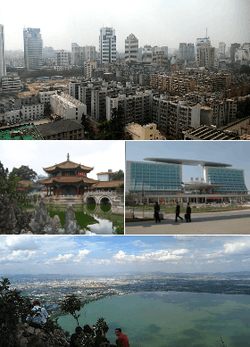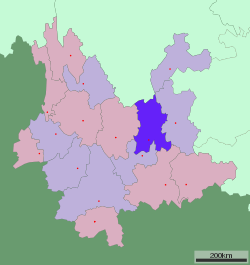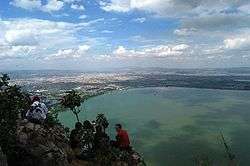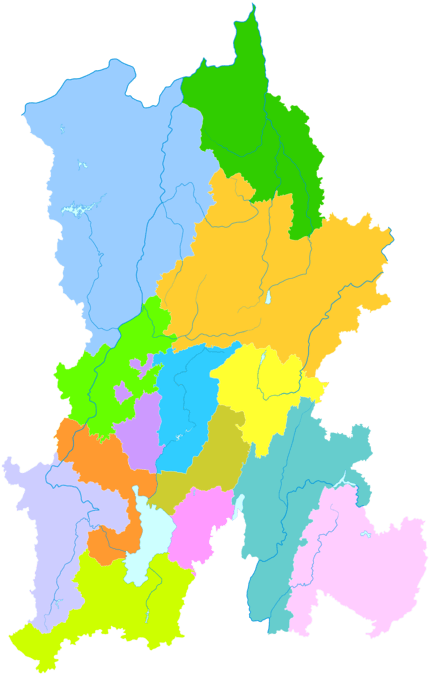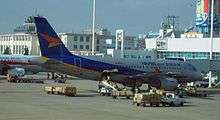Kunming
Kunming is the capital and largest city of Yunnan province in southwest China.[5] Known as Yunnan-Fu until the 1920s, today it is a prefecture-level city and the political, economic, communications and cultural centre of the province as well as the seat of the provincial government. Kunming is also called the Spring city due to its weather. The headquarters of many of Yunnan's large businesses are in Kunming. It was important during World War II as a Chinese military center, American air base, and transport terminus for the Burma Road. Located in the middle of the Yunnan–Guizhou Plateau, Kunming is located at an altitude of 1,900 metres (6,234 feet) above sea level and at a latitude just north of the Tropic of Cancer. Kunming has as of 2014 a population of 6,626,000 with an urban population of 4,575,000,[6] and is located at the northern edge of the large Lake Dian, surrounded by temples and lake-and-limestone hill landscapes.
Kunming consists of an old, previously walled city, a modern commercial district, residential and university areas. The city has an astronomical observatory, and its institutions of higher learning include Yunnan University, Yunnan Normal University and a medical college. On the outskirts is a famed bronze temple, dating from the Ming dynasty.
Its economic importance derives from its geographical position. Positioned near the border with Southeastern Asian countries, serving as a transportation hub in Southwest China, linking by rail to Vietnam and by road to Burma and Laos. This positioning also makes it an important trade center in this region of the nation. It also houses some manufacturing, chiefly the processing of copper, as well as various chemicals, machinery, textiles, paper and cement. Though having a nearly 2,400 year history, its modern prosperity dates only from 1910, when the railway from Hanoi was built. The city has continued to develop rapidly under China's modernization efforts. Kunming's streets have widened while office buildings and housing projects develop at a fast pace. Kunming has been designated a special tourism center and as such sports a proliferation of high-rises and luxury hotels.
History
Early history
Kunming long profited from its position on the caravan roads through to South-East Asia, India and Tibet. Early townships in the southern edge of Lake Dianchi (outside the contemporary city perimeter) can be dated back to 279 BC, although they have been long lost to history. Early settlements in the area around Lake Dian date back to Neolithic times. The Dian Kingdom, whose original language was likely related to Tibeto-Burman languages was also established near the area.[7]
Dian was subjugated by the Chinese Han dynasty under the reign of Emperor Wu of Han in 109 BC. The Han dynasty incorporated the territory of the Dian Kingdom into their Yizhou Commandery, but left the King of Dian as the local ruler.
The Han dynasty (205 BC–AD 220), seeking control over the Southern Silk Road running to Burma and India, brought small parts of Yunnan into China's orbit, though subsequent dynasties could do little to tame what was then a remote and wild borderland. During the Sui dynasty (581–618), two military expeditions were launched against the area, and it was renamed Kunzhou in Chinese sources.
Medieval China

Founded in 765, Kunming was known to the Chinese as Tuodong (拓东) city in the Kingdom of Nanzhao (737–902) during the 8th and 9th centuries. Tuodong later became part of the successor Kingdom of Dali (937–1253). Eventually this changed when Tuodong came under the control of the Yuan dynasty invasion of the southwest in 1252–1253. In 1276 it was founded by the Mongol rulers as Kunming County and became the provincial capital of Yunnan. The city grew as a trading center between the southwest and the rest of China. It is considered by scholars to have been the city of Yachi Fu (Duck Pond Town) where people had used cowries as cash and ate their meat raw, as described by the 13th-century Venetian traveler Marco Polo who traveled to the area and wrote about his fascination with the place.
Ming and Qing dynasties
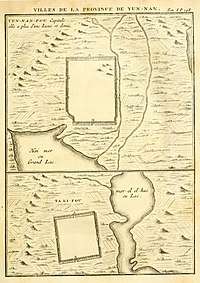
In the 14th century, Kunming was retaken when the Ming dynasty defeated the Mongols, who built a wall surrounding present-day Kunming. Ming General Wu Sangui defected to Manchu invaders 300 years later and held the city until his death in 1678, long after the rest of China had fallen under Manchu rule. During the Ming and Qing dynasties, it was the seat of the superior prefecture of Yunnan.
The area was first dubbed Kunming in the period towards the decline of the Yuan dynasty and later still in 1832, the beginnings of a real city were acknowledged within the city walls and significant structures within their confines. Founding of the city can, therefore be said to have been a predominantly 19th century affair. It was also in this century that the city grew to become the major market and transport centre for the region. Many of the city's inhabitants were displaced as a result of the 1833 Kunming earthquake.
Kunming suffered at the hands of rebel leader Du Wenxiu, the Sultan of Dali, who attacked and besieged the city several times between 1858 and 1868. Little of the city's wealth survived the 1856 Panthay Rebellion, when most of the Buddhist sites in the capital were razed. Decades later, Kunming began to be influenced by the West, especially from the French Empire. In the 1890s, an uprising against working conditions on the Kunming–Haiphong rail line saw many laborers executed after France shipped in weapons to suppress the revolt. The meter-gauge rail line, only completed by around 1911, was designed by the French so that they could tap Yunnan's mineral resources for their colonies in Indochina.
Kunming was a communications center in early times and a junction of two major trading routes, one westward via Dali and Tengchong County into Myanmar, the other southward through Mengzi County to the Red River in Indochina. Eastward, a difficult mountain route led to Guiyang in Guizhou province and thence to Hunan province. To the northeast was a well-established trade trail to Yibin in Sichuan province on the Yangtze River. But these trails were all extremely difficult, passable only by mule trains or pack-carrying porters.
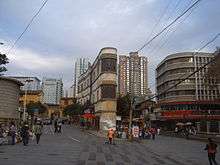
After Qing dynasty
"In the late 1800s, the French started to build the Kunming-Haiphong railway for trade and shipping of weapons".[8]
Kunming reverted to county status in 1912, under the name Kunming, and became a municipality in 1935. The opening of the Kunming area began in earnest with the completion in 1906–1910 of the Yunnan-Vietnam Railway to Haiphong in north Vietnam (part of French Indochina).
After becoming a treaty port (in 1908)
Kunming became a treaty port opening to foreign trade in 1908 and soon became a commercial center.
A university was set up in 1922. In the 1930s the first highways were built, linking Kunming with Chongqing in Sichuan and Guiyang in Guizhou to the east. Kunming was transformed into a modern city as a result of the outbreak of the Second Sino-Japanese War in 1937 when the invading Japanese forces caused a great number of east-coast Chinese refugees, some of whom were wealthy, to flood into the southwest of China. They brought with them dismantled industrial plants, which were then re-erected beyond the range of Japanese bombers. In addition, a number of universities and institutes of higher education were evacuated there. The increased money and expertise quickly established Kunming as an industrial and manufacturing base for the wartime government in Chongqing.
As China's military forces and civilians retreated outside the reach of the Japanese military forces a year prior to the outbreak of the Second World War in Europe, Kunming became a new training hub for the battered but regrouped Chinese Air Force in which Lieutenant General Claire Lee Chennault took command of cadet training duties in the summer of 1938.[9][9] During the Second World War the city of Kunming was prepared as a National Redoubt in case the temporary capital in Chongqing fell, an elaborate system of underground caves to serve as offices, barracks and factories was prepared but never utilised. Kunming was to have served again in this role during the ensuing Chinese Civil War, but the Nationalist garrison switched sides and joined the Communists. Instead Taiwan would become the last redoubt and home of the Chinese Nationalist government, a role it fulfills to this day.[10]
When the Japanese occupied French Indochina in 1940, the links between Kunming and the west grew increasingly vital as Allied forces provided essential support by importing materials from Burma. By this time, Kunming acted as an Allied military command center, which grouped the Chinese, American, British and French forces together for operations in Southeast Asia. The Office of Strategic Services' Service Unit Detachment 101 (predecessor to the 1st Special Forces Group) was also headquartered in Kunming and whose mission was to divert and disrupt Japanese combat operations in Burma.[11]

Later in the war, Kunming was targeted by the Imperial Japanese Air Force during its bombing campaigns, and when the Burma Road was lost to the Japanese, the American Volunteer Group, known as the "Flying Tigers", used Kunming as a base in 1941 and 1942 to fly in supplies over the Himalayas from British bases in India in defiance of Japanese assaults. They also were tasked with defending China's lifeline to the outside world, the Burma Road and the Ledo Road, which had Kunming as a northern terminus.[12]
Industry became important in Kunming during World War II. The large state-owned Central Machine Works[13] was transferred there from Hunan, while the manufacture of electrical products, copper, cement, steel, paper, and textiles expanded.
After World War II
Until 1952, Kunming was a walled city. The city government in 1952 ordered hundreds of young people to tear down the wall and use its bricks to make a new road running north-south. To show its appreciation for the young people that demolished the east wall, the city government named the new street after them. Their existence still echoes today in place names like Xiao Ximen (小西门, 'Lesser west gate') and Beimen Jie (北门街, 'North gate Street'). There are also less obvious connections to the wall, such as Qingnian Lu (青年路, 'Youth Road'), which was once Kunming's east wall.
After 1949, Kunming developed rapidly into an industrial metropolis with the construction of large iron and steel and chemical complexes, along with Chongqing, Chengdu and Guiyang in the southwest. A Minorities' Institute was set up in the 1950s to promote mutual understanding and access to university education among Yunnan's multiethnic population. The city consolidated its position as a supply depot during the Vietnam War and subsequent border clashes. Until Mao Zedong's death, Kunming was still generally thought in much of the rest of the country as a remote frontier settlement and so it acted as a place up to then for the government to exile people who had fallen politically out of favor, especially during the Cultural Revolution.
In 1957, Kunming's rail link to Hanoi was re-opened (after being cut during World War II). It was cut again in 1979.
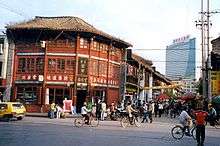
Since the economic reforms of the mid-1980s, Kunming has enjoyed increased tourism and foreign investment, for instance investors from Thailand trace their ancestries back to Yunnan. Several Thai Chinese banks have offices in Kunming, for example, Kasikorn Bank and Krung Thai Bank. Princess Maha Chakri Sirindhorn of Thailand has visited Kunming many times to study Chinese culture and promote friendly relations.
Rail link to Vietnam re-opened again in 1996.
In July 2005, the second Greater Mekong Subregion (GMS) Summit was held in Kunming, with government leaders from China, Laos, Myanmar (Burma), Thailand, Cambodia, and Vietnam participating. There, China agreed to lend its neighbors more than $1 billion for a series of projects. China was then promoting GMS cooperation as a first step toward building an eventual China-ASEAN Free Trade Area.
Infrastructure improvements have been underway to improve links between Kunming and Southeast Asia in time for the 2010 China-ASEAN Free Trade Area. The FTA is expected to make Kunming a trade and financial center for Southeast Asia. In addition to physical improvements to enhance Kunming's trade with Southeast Asia, the central and provincial governments have made financial preparations to assist the city's emergence. At the end of 2004, the central government approved Kunming to be one of the 18 mainland cities in which foreign banks could conduct business in renminbi.
In the 1980s and 1990s, the city center was rebuilt, with Swiss help, in its current 'modern' style to impress visitors attending the 1999 World Horticultural Exposition.[14] It was primarily during 1997 and 1998 that much of the city's roads, bridges and high rises were built.
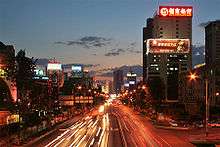
The World Horticultural Expo was widely regarded as a public relations success for Kunming. Today the after-effects of the Expo are apparent in more than just the physical improvements to the city—it was the Expo that made the outside world take notice of Kunming, which was relatively unknown at the time.
In July 2006, talks at the ASEAN Regional Forum, China, Bangladesh and Myanmar (Burma) agreed to construct a highway from Kunming to Chittagong through Mandalay for trade and development.[15]
On 1 March 2014, 29 people died, and more than 130 were injured at Kunming Railway Station in what the Chinese Xinhua News Agency described as a terrorist attack.[16]
Geography
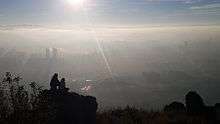

Kunming is located in east-central Yunnan province. It is located between north latitude 24°23' and 26°22' N, and east longitude 102°10' and 103°40' E, with a total area of 21,600 square kilometres (8,340 square miles). Its widest stretch from the east to the west amounts to 140 kilometres (87 miles) and its largest expansion from the north to the south amounts to 220 kilometres (137 miles).
Situated in a fertile lake basin on the northern shore of the Lake Dian and surrounded by mountains to the north, west, and east, Kunming has always played a pivotal role in the communications of southwestern China. Lake Dian, titled as "the Pearl of the Plateau", is the sixth largest fresh water lake in China, is the largest lake in Yunnan and has an area of approximately 340 square kilometres (130 square miles). Kunming's highest point is Mazong Ridge of the Jiaozi Mountain in Luquan with an elevation of 4,247 metres (13,934 feet), and its lowest point is the joint of the Xiao River and the Jinsha River in Dongchuan District, with an elevation of 695 metres (2,280 feet). Its downtown area is 1,891 metres (6,204 feet) above sea level.
About 96 km (60 mi) southeast of the city centre is the Stone Forest in Shilin County, a karst formation developed as a tourist attraction consisting of rock caves, arches, and pavilions. It is part of the larger karst-based landscape of the area.
Climate
Located at an elevation of 1,890 metres (6,200 feet) on the Yunnan–Guizhou Plateau with low latitude and high elevation, Kunming has one of the mildest climates in China, characterised by short, cool dry winters with mild days and crisp nights, and long, warm and humid summers, but much cooler than the lowlands. The weather never gets very hot in summer; the temperature has exceeded 30 °C (86 °F) only on a handful of occasions. However, freak snowfalls occur in occasional winters. Controlled by a subtropical highland climate (Köppen Cwb), the monthly 24-hour average temperature ranges from 8.9 °C (48.0 °F) in January to 20.3 °C (68.5 °F) in June, with daily high temperatures reaching their lowest point and peak in December and May, respectively. With its perpetual spring-like weather which provides the ideal climate for plants and flowers, Kunming is known as the "City of Eternal Spring". The city is covered with blossoms and lush vegetation all-year round.[17] The period from May to October is the rainy season and the rest of the year is dry. The city has an annual mean temperature of 15.52 °C (59.9 °F), rainfall of 979 millimetres (38.5 in) (nearly three-fifths occurring from June to August) and a frost-free period of 230 days. With monthly percent possible sunshine ranging from 30% in July to 69 percent in February and March, the city receives 2,198 hours of bright sunshine annually. Extreme temperatures in the city have ranged from −7.8 to 31.3 °C (18 to 88 °F).
| Climate data for Kunming (1981–2010) | |||||||||||||
|---|---|---|---|---|---|---|---|---|---|---|---|---|---|
| Month | Jan | Feb | Mar | Apr | May | Jun | Jul | Aug | Sep | Oct | Nov | Dec | Year |
| Record high °C (°F) | 23.3 (73.9) |
25.6 (78.1) |
28.2 (82.8) |
30.4 (86.7) |
31.3 (88.3) |
30.0 (86) |
30.3 (86.5) |
30.3 (86.5) |
30.4 (86.7) |
27.4 (81.3) |
25.3 (77.5) |
25.1 (77.2) |
31.3 (88.3) |
| Average high °C (°F) | 15.9 (60.6) |
17.9 (64.2) |
21.1 (70) |
24.0 (75.2) |
24.6 (76.3) |
24.6 (76.3) |
24.4 (75.9) |
24.7 (76.5) |
23.1 (73.6) |
20.9 (69.6) |
18.0 (64.4) |
15.5 (59.9) |
21.2 (70.2) |
| Daily mean °C (°F) | 8.9 (48) |
10.9 (51.6) |
14.1 (57.4) |
17.3 (63.1) |
19.2 (66.6) |
20.3 (68.5) |
20.2 (68.4) |
19.9 (67.8) |
18.3 (64.9) |
16.0 (60.8) |
12.1 (53.8) |
9.0 (48.2) |
15.5 (59.9) |
| Average low °C (°F) | 3.5 (38.3) |
5.0 (41) |
8.0 (46.4) |
11.4 (52.5) |
14.7 (58.5) |
17.0 (62.6) |
17.3 (63.1) |
16.8 (62.2) |
15.2 (59.4) |
12.7 (54.9) |
7.9 (46.2) |
4.2 (39.6) |
11.1 (52.1) |
| Record low °C (°F) | −2.8 (27) |
−1.6 (29.1) |
−5.2 (22.6) |
2.0 (35.6) |
5.5 (41.9) |
10.8 (51.4) |
11.6 (52.9) |
11.5 (52.7) |
6.2 (43.2) |
4.0 (39.2) |
−0.8 (30.6) |
−7.8 (18) |
−7.8 (18) |
| Average precipitation mm (inches) | 15.8 (0.622) |
14.6 (0.575) |
17.6 (0.693) |
25.2 (0.992) |
85.5 (3.366) |
170.4 (6.709) |
200.2 (7.882) |
203.9 (8.028) |
113.9 (4.484) |
81.7 (3.217) |
36.7 (1.445) |
13.6 (0.535) |
979.1 (38.548) |
| Average precipitation days (≥ 0.1 mm) | 4.4 | 4.6 | 5.5 | 6.8 | 12.2 | 17.4 | 20.3 | 19.3 | 15.8 | 13.0 | 7.3 | 3.8 | 130.4 |
| Average relative humidity (%) | 66 | 60 | 56 | 56 | 66 | 77 | 81 | 80 | 79 | 79 | 75 | 72 | 71 |
| Mean monthly sunshine hours | 224.5 | 219.6 | 255.4 | 244.8 | 212.2 | 135.0 | 124.3 | 144.9 | 123.5 | 143.7 | 169.8 | 200.0 | 2,197.7 |
| Percent possible sunshine | 68 | 69 | 69 | 64 | 52 | 33 | 30 | 36 | 34 | 40 | 52 | 61 | 50 |
| Source #1: China Meteorological Data Service Center | |||||||||||||
| Source #2: China Meteorological Administration(precipitation days, sunshine hours 1971–2000) | |||||||||||||
Natural resources
Mineral resources include phosphorus, salt, magnesium, titanium, coal, quartz sand, clay, silica, copper. Phosphorus and salt mines are the most plentiful. Kunyang Phosphorus Mine is one of the three major phosphorus mines in the country. Rock salt reserves are 1.222 billion tonnes (1.203 billion long tons; 1.347 billion short tons) and mirabilite reserves are 1.908 billion tonnes (1.878 billion long tons; 2.103 billion short tons). Dongchuan is a major copper production base.
Proven reserves of Coal bed gas is about 500 billion cubic metres (18,000 billion cubic feet), equal to 720 million tonnes (710 million long tons; 790 million short tons) of standard coal.[18] Geothermal resources are widely distributed.
Environment and horticulture
Kunming has 2,585 hectares (6,390 acres) of lawns, trees and flowers, averaging 4.96 square metres (53.4 square feet) per capita and a green space rate of 21.7 percent. The city's smoke control area is 115 square kilometres (44 square miles) and noise control area 87 square kilometres (34 square miles).
Kunming is a significant horticultural center in China, providing products such as grain, wheat, horsebeans, corn, potato and fruit such as peaches, apples, oranges, grapes and chestnuts. Kunming is world-famous for its flowers and flower-growing exports. More than 400 types of flowers are commonly grown in Kunming. The camellia, Yulan magnolia, azalea, fairy primrose, lily and orchid are known as the six famous flowers of the city.
The camellia was confirmed by the Municipality of Kunming as its city flower in 1983.
The Kunming city government plans to create an environmental trial court to deal with environment-related lawsuits. It is to be part of the city's intermediate people's court and will have jurisdiction over appeals by companies that have been found guilty of violating environmental laws in cities throughout Yunnan.[19]
Demographics
Of the more than five million people registered as residents in Kunming in 2006, more than four million were Han. The Yi people were the most prominent minority in the city, with more than 400,000 residents. The least-represented ethnic minority in Kunming were the 75 Dulong people living in the city.
Registered ethnic populations of Kunming as of 2006:[20]
- Han (汉族): 4,383,500
- Yi (彝族): 400,200
- Hui (回族): 149,000
- Bai (白族): 73,200
- Miao (苗族): 46,100
- Lisu (傈僳族): 17,700
- Zhuang (壮族): 14,000
- Dai (傣族): 13,200
- Hani (哈尼族): 11,000
- Naxi (纳西族): 8,400
- Manchu (满族): 4,800
- Buyei (布依族): 3,400
- Mongol (蒙古族): 2,500
- Lahu (拉祜族): 1,700
- Tibetan (藏族): 1,500
- Yao (瑶族): 1,100
- Jingpo (景颇族): 1,100
- Va (佤族): 1,000
- Blang (布朗族): 441
- Primi (普米族): 421
- Sui (水族): 294
- Achang (阿昌族): 263
- Nu (怒族): 156
- Jino (基诺族): 135
- Derung (独龙族): 75
Cityscape
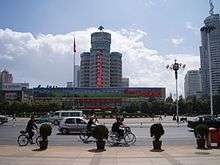
The city center has three major squares and five major streets: Jinma Biji Square, Nanping Square and Dongfeng Square along with Nanping Jie, Jinbi Lu, Renmin Lu, Zhengyi Lu and Jingxin Jie. Qingnian Lu, Zhengyi Lu, and Renmin Lu are the main commercial areas in Kunming; the most popular pedestrian streets are Nanping Jie, Jingxing Birds-Flowers' Market, and Jinma Biji Fang.
Kunming's public focus is the huge square outside the now-demolished Workers' Cultural Hall at the Beijing Lu-Dongfeng Lu intersection, where in the mornings there are crowds doing taijiquan and playing badminton. Weekend amateur theatre are also performed in the square. Rapidly being modernized, the city's true center is west of the square across the adjacent Panlong River (now more of a canal), outside the Kunming Department Store at the Nanping Lu/Zhengyi Lu crossroads, a densely crowded shopping precinct packed with clothing and electronics stores. The river is polluted, black and oily. Surrounding the area are plenty of new high-rises.
The center is an area of importance to Kunming's Hui population, with Shuncheng Jie, one of the last old streets in the center of the city, previously forming a Muslim quarter. Until shortly before 2005, this street was full of wind-dried beef and mutton carcasses, pitta bread and raisin sellers, and huge woks of roasting coffee beans being stirred with shovels. Under Kunming's rapid modernisation, however, the street has been demolished to make way for apartments and shopping centers. Rising behind a supermarket one block north off Zhengyi Lu, Nancheng Qingzhen Si is the city's new mosque, its green dome and chevron-patterned minaret visible from afar and built on the site of an earlier Qing edifice.
Running west off Zhengyi Jie just past the mosque, Jingxing Jie leads into one of the more bizarre corners of the city, with Kunming's huge Bird and Flower Market convening daily in the streets connecting it with the northerly, parallel Guanghua Jie. The market offers many plants such as orchids that have been collected and farmed across the province. In the small grounds of Wen Miao, a now vanished Confucian temple off the western end of Changchun Lu, there is an avenue of pines, an ancient pond and pavilion, and beds of bamboo, azaleas and potted palms.
Jinbi Lu runs roughly parallel to and south of Dongfeng Lu, reached from Beijing Lu. Two large Chinese pagodas rise in the vicinity, each a solid thirteen storeys of whitewashed brick crowned with four iron cockerels. The West Pagoda was built between 824 and 859, during the Tang dynasty; its original counterpart, the East Pagoda, was built at the same time, but was destroyed by an earthquake in 1833 and rebuilt in the same Tang style in 1882. South down Dongsi Jie, past another mosque, the entrance to the West Pagoda is along a narrow lane on the right. In the tiny surrounding courtyard, sociable idlers while away sunny afternoons playing cards and sipping tea in the peaceful, ramshackle surroundings. The East Pagoda is a more cosmetic, slightly tilted duplicate standing in an ornamental garden a few minutes' walk east on Shulin Jie. The temples associated with both pagodas are closed to the public.
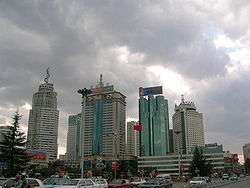
Parks
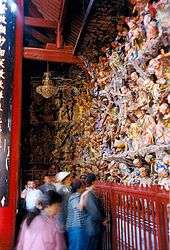
Cuihu Park (Green Lake Park) is one of Kunming's major parks and is predominately a lake surrounded by greenery. Located in the west side of the park is the statue of one of Yunnan's most famous patriots—Nie Er, the composer of China's national anthem. Now it is open to public for free.
Daguan Park lies on Dian Chi in Kunming's southwestern limits. Originally laid out by the Kangxi Emperor in the Qing dynasty, it has been modified over the years to include a noisy funfair, food stalls and emporiums, and is a favourite haunt of Kunming's youth.
Kunming's zoo, founded in 1950, is adjoined to Yuantong Park. The zoo houses 5,000 animals from 140 species and receives 3 million visitors a year.[21]
Other parks in Kunming include Black Dragon Pool, and the Kunming Botanical Gardens in the north, and Wenmiao Tea Garden in Wuhua District.
Landmarks
The "Garden of the World Horticultural Exposition", located in the northern suburbs of Kunming, is six kilometres (3.7 miles) from central Kunming. From 1 May to 31 October 1999, Kunming held the 1999 World Horticulture Exposition, with the theme of "Man and Nature—Marching Toward the 21st Century".
The "Golden Hall Scenic Zone", located on the Mingfeng Hill in the northern suburbs of Kunming, is eight kilometres (5.0 miles) from central Kunming. Constructed in 1602 (the 30th year of the Wanli reign period of the Ming dynasty), all of its beams, pillars, arches, doors, windows, tiles, Buddhist statues, and horizontal inscribed boards are made of copper, weighing more than 200 tons. It is the largest copper building in China.
Notable museums in Kunming:
- Yunnan Provincial Museum
- Kunming City Museum (redeveloped in 2014)
- Kunming Natural History Museum of Zoology (opened in November 2006)
- Yunnan Ethnology Museum (opened 1995)
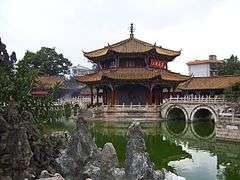
Yuantong Si is Kunming's major Buddhist temple. It is Kunming's largest and most famous temple with the original structure being first constructed more than 1,200 years ago during the Tang dynasty. The temple sits in a depression on the southern side of Yuantong Park. Northwest about 12 km (7.5 mi) from the city center is the Qiongzhu Si (Bamboo Temple) built in 639 and rebuilt in 1422 to 1428. Numerous Buddhist temples line the road to the Dragon Gate (龙门) in the Western Mountains (西山).
Administrative divisions
The prefecture-level city of Kunming has jurisdiction over 14 subdivisions; seven districts, one county-level city, three counties and three autonomous counties.
Kunming is bounded by Qujing City to the east, Honghe Hani and Yi Autonomous Prefecture to the southeast and Yuxi City to the southwest, Chuxiong Yi Autonomous Prefecture to the west and Zhaotong City to the northeast. Kunming also borders with Panzhihua prefecture level city and Liangshan Yi Autonomous Prefecture of Sichuan province.
Kunming plans to add two new districts to its existing four urban districts (Panlong, Wuhua, Guandu, Xishan) over the next few years.
| Map | ||||||
|---|---|---|---|---|---|---|
| Name | Simplified Chinese | Hanyu Pinyin | Population (2010 Census) |
Area (km²) | Density (/km²) | |
| City Proper | ||||||
| Chenggong District | 呈贡区 | Chénggòng Qū | 310,843 | 541 | 574.571 | |
| Panlong District | 盘龙区 | Pánlóng Qū | 809,881 | 861 | 2,382.002 | |
| Wuhua District | 五华区 | Wǔhuá Qū | 855,521 | 398 | 2,149.550 | |
| Guandu District | 官渡区 | Guāndù Qū | 853,371 | 552 | 1,545.961 | |
| Xishan District | 西山区 | Xīshān Qū | 753,813 | 791 | 952.987 | |
| Suburban | ||||||
| Jinning District | 晋宁区 | Jìnníng Qū | 283,784 | 1,391 | 204.014 | |
| Dongchuan District | 东川区 | Dōngchuān Qū | 271,917 | 1,674 | 162.435 | |
| Satellite city | ||||||
| Anning City | 安宁市 | Ānníng Shì | 341,341 | 1,313 | 259.970 | |
| Rural | ||||||
| Fumin County | 富民县 | Fùmín Xiàn | 145,554 | 1,030 | 141.314 | |
| Yiliang County | 宜良县 | Yíliáng Xiàn | 419,400 | 1,880 | 223.085 | |
| Songming County | 嵩明县 | Sōngmíng Xiàn | 287,095 | 920 | 199.095 | |
| Shilin Yi Autonomous County | 石林彝族自治县 | Shílín Yízú Zìzhìxiàn | 246,220 | 1,777 | 138.559 | |
| Luquan Yi and Miao Autonomous County | 禄劝彝族苗族自治县 | Lùquàn Yízú Miáozú Zìzhìxiàn | 396,404 | 4,378 | 90.544 | |
| Xundian Hui and Yi Autonomous County | 寻甸回族彝族自治县 | Xúndiàn Huízú Yízú Zìzhìxiàn | 457,068 | 3,966 | 115.246 | |
Society and culture
Leisure and entertainment
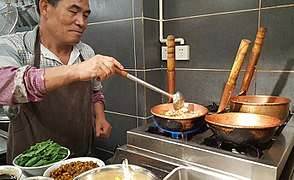
Within Kunming, the entertainment district has its focus around Kundu Square, with many cinemas, bars, clubs and restaurants. Food aside, one feature of less formal Yunnanese restaurants is that they often have a communal bamboo water pipe and tobacco for their customers. There are plenty of student bars and clubs. The city has several operatic troupes and indigenous entertainments which include huadeng, a lantern dance. Although indoor performances are lacking, there are often informal shows at the weekend outside the Workers' Cultural Hall and in Cuihu Park. There are similar shows at the Yunnan Arts Theater on Dongfeng Xi Lu. Kunming's main cinema house is on the south side of the Dongfeng Lu/Zhengyi Lu intersection. The other main multiplex, the XJS, at the junction of Wenlin Jie and Dongfeng Xi Lu.
Language
The Kunming dialect is very similar to that of Sichuan and Guizhou but uses the third tone much less than standard Chinese. Many terms are used only in Kunming dialect, such as "板扎" meaning 'terrific'.
Tourism
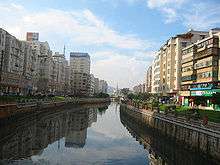
Kunming attracts domestic and foreign tourists year round. At the center of Yunnan and as its capital, Kunming is also a transport hub for tourists heading to other parts of Yunnan such as Dali, Lijiang and Shangrila.
Conference and exhibition venues in Kunming include the Kunming International Convention and Exhibition Center and the Yunnan Provincial Science and Technology Hall.
Kingdom of the Little People, a theme park featuring performers with dwarfism, is also located near Kunming.[22]
Other famous attractions include Stone Forest and Yunnan's Ethnic Village.
Sports
Every year, many Chinese and international athletes come to Kunming for high-altitude training. The city has been China's national high-elevation training base for more than 30 years. There are two major training complexes, Hongta Sports Center and Haigeng National Training Center.[23]
Hongta Sports Center was built in 2000 by Hongta (Red Pagoda) cigarette company, at a cost of US$58 million. Located near Haigeng Park, the complex is mostly used by professional athletes, but also acts as a sports club for the general public. Every weekend, it hosts amateur football matches. Aside from about 10 football pitches, including one surrounded by a running track, Hongta also has a 50-metre (160-foot) swimming pool, a badminton gymnasium, tennis courts and a basketball court. It also has one of China's few ice hockey rinks, and a workout room with treadmills and weightlifting machines. There are also game rooms for air hockey; also pool tables and a basement bowling alley. The complex comes complete with a 101-room hotel and restaurant.[23]
Haigeng National Training Center is located ten minutes away from Hongta on Dianchi (Lake Dian) near Kunming's award-winning Lakeview Golf Club and new condominium developments. This complex dates from the late 1970s and was built by the government specifically to specialize in high-altitude training.[23]
Golf
Golf is a major attraction in Kunming. There are four golf courses within an hour's drive of downtown. For the last six years , Spring City Golf and Lake Resort in nearby Yiliang County has reigned as the best golf course in China and Hong Kong according to US Golf Digest. In 2004, it was named Asia's best golf resort by Asian Golf Monthly.[24] It hosts the Kunming Leg of the Omega China Tour.
Kunming has attracted foreign investment in golf course development. "Spring City" Golf Resort is a US$600 million project that began as an investment led by Singapore's Keppel Land Group in 1992. Jack Nicklaus and course designer Robert Trent Jones, Jr designed the two courses.[24]
Sport facilities
Major sports facilities include:
- Tuodong Sports Center, a multi-purpose venue
- Golf: Spring City Golf and Lake Resort, its 'Mountain Course' was designed by Jack Nicklaus
- Lakeview Golf Villa
- Cuihu Park tennis courts
- Kunming Municipal Athletic Center
- Kunming Gymnasium
- Yunnan Provincial Stadium, home to Hongta Yunnan Football Club
- Wuhua District Stadium
Economy
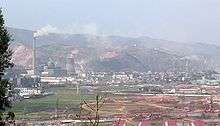
Kunming has three economic advantages over other cities in southwest China: significant natural resources, a large consumer market and a mild climate. Due to its position at the center of Yunnan, one of China's largest producers of agricultural products, minerals and hydroelectricity, Kunming is the main commercial hub for most of the province's resources.
Kunming's chief industries are copper, lead and zinc production. Its iron and steel industry has been expanded. Salt and phosphate mines around Kunming are some of the largest in China. Yunnan Copper Company Limited, based in Kunming, is one of Yunnan's largest mining corporations. From the late 1970s, Kunming's main industries also came to include food and tobacco processing and the manufacture of construction equipment and machines.
In May 1995, the State Council approved Kunming as an Open City. By the end of 1995, the city had approved 929 overseas-funded enterprises with a total investment of $2.3 billion including $1.1 billion of foreign capital. More than 40 projects each had an investment of more than $9 million.
Kunming is a center of engineering and the manufacture of machine tools, electrical machinery, equipment and automobiles (including heavy goods vehicles). It has a chemical industry, and plastics, cement works and textile factories. Its processing plants, which include tanneries, woodworking and papermaking factories, use local agricultural products. In 1997, Yunnan Tire Co. opened a tire plant in Kunming, with a capacity to produce two million tires per year.
Development zones
Kunming has two major development zones, Kunming High-tech Industrial Development Zone (biological medicine, new materials, electronic information, photoelectron, agriculture) and Kunming Economic and Technology Development Zone (mechanical equipment production, biological science and food industry, information industry, software).
Industrial parks
There are 30 key industrial parks promulgated and recognized by National Development and Reform Commission in Yunnan Province.[25]
The largest include:
- Chenggong Industrial Park
- Anning Industrial Park
- Songming Yanglin Industrial Development Zone
- Dongchuan Special Industrial Park
- Xundian Special Industrial Park
- Kunming Haikou Industrial Park.
Companies
As of 2008, Kunming is home to 65 of the Top 100 Enterprises in Yunnan Province. The top 100 enterprises were based on their revenues for 2007. Hongta Group, with revenues of some RMB39.88 billion for 2007 topped the list. The tobacco sector remains the largest sector in the province.
Flower industry
Yunnan has developed into the largest flower export base in Asia, with many Dutch experts having transferred technology to the area. The Dounan Flower Market, located in suburban Kunming, is the largest in China with daily sales of 2.5 million yuan (US$300,000) from the 2 million sprays of flowers (as of 2006). The provincial government agency, the Yunnan Flower Association, regulates the industry.[26]
Logistics
Kunming East Station is at present Yunnan province's only container handling depot, with direct links to only three provinces; Guangdong, Guizhou and Sichuan. It also has direct access to the metropolitan district of Chongqing.
The Jiaying Depot is connected with the new system of highways built linking Yunnan to the increasingly important markets of Southeast Asia, facilitating cheap Chinese exports to the region and granting resource-poor China greater access to the region's massive raw material resources. Yunnan has thereby become a progressively important area in the Southwest's rail logistics both in terms of national and international logistics.
Solar energy
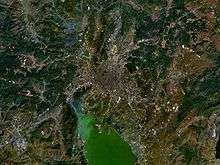
In July 2008, Kunming began to implement a program to transform the city's solar energy industry into a US$8.8 billion industrial base in China by 2013. Kunming receives an annual average sunshine of more than 2,400 hours. Each 1 kW PV system has the potential to generate 1500 kilowatt-hours of electricity a year from solar energy.
As of 2007, the Kunming Economic Committee listed about 130 solar energy enterprises in the city. Of these, 118 enterprises produce solar lamps and solar water heaters, with a combined total production value of about US$43.8 million, and 10 enterprises are engaged in solar photovoltaic cells manufacturing, with a total production value of about US$51.2 million.[27]
Suntech Power announced in December 2008 that it was jointly constructing a solar energy project with Yunnan Provincial Power Investment and other investors. The 1MW first-phase of the Shilin 66MW on-grid solar power station began generating power on 28 December 2009. The initial phase of the 66MW project was originally scheduled to start production in first half of 2010 while the 20MW second phase and 36 MW third phase were under construction.
Transport
Kunming is situated on the Yunnan–Guizhou Plateau. Rail and air are the main two methods to travel to or from Kunming from outside Yunnan.
Air transport
Kunming has air connections with several Chinese and Southeast Asian cities. Kunming is served by Kunming Changshui International Airport (KMG), which opened at 08:00 on 28 June 2012, replacing the older international airport, which was located 4–5 km (2.5–3.1 mi) southeast of central Kunming.
The now defunct Yunnan Airlines was headquartered in Kunming until it was acquired by China Eastern Airlines. China Southwest Airlines used to operate routes to and from Kunming, until it was merged with Air China.
Lucky Air is a budget airline based in Kunming and operates scheduled services from Dali to Kunming and Xishuangbanna, and plans to expand to other areas of China.
Highway

China National Highways 108, 213 and 320 intersect in Kunming. Highways link Kunming to Thailand, Vietnam and Laos, and provide Yunnan province access to seaports of Southeast Asia.
Rail
Kunming is the main rail hub of Yunnan province. The Chengdu–Kunming Railway from Sichuan, Shanghai–Kunming Railway from Guizhou, and Nanning–Kunming Railway from Guangxi converge in Kunming from the north, northeast and east. The Yunnan–Vietnam Railway runs from Kunming southeast to Hekou and Lao Cai on the Sino-Vietnamese border and then on to Haiphong The Kunming–Yuxi Railway runs south to Yuxi, where a second rail line to Vietnam is being planned and built. To the west of Kunming, the Guangtong–Dali Railway extends off the Chengdu–Kunming Line to Dali (Xiaguan Town).
Kunming has three major railway stations:
- Kunming Railway Station is at the southern end of Beijing Xi Lu. Compared with the other railway station (North Railway Station), Kunming Railway Station services most of the "conventional" (not high-speed) trains to places to other provinces of China. Trains run north to Chengdu, southeast via Xingyi to Baise and Nanning in Guangxi, and east through Guizhou, via Liupanshui, Anshun, Guiyang, into the rest of the country.
- Kunming South Railway Station, opened at the end of 2016, is located in Chenggong District, many miles southeast from the historical city center. It is the western terminal of the Shanghai–Kunming High-Speed Railway and the Guangzhou–Nanning–Kunming High-Speed Railway, and has high-speed service to destinations along these lines and elsewhere on the nation's high-speed network.
- Kunming North Railway Station (serviced by the No. 23 Bus) is on the heritage 1,000 mm (3 ft 3 3⁄8 in) metre gauge Kunming–Hai Phong Railway, which runs to Hekou and Vietnam. Most of the station has been converted into a museum. Due to the deterioration of the railway line, the long distance narrow-gauge service has been cancelled; however, as of 2012, some local narrow gauge service still operates at Kunming North Railway Station, in particular two daily trains to Shizui (石咀) Station on the western outskirts of Kunming, and to Wangjiaying (王家营) east of the city.[28]
As of 2017, railway development projects continue to proceed in the Kunming metropolitan area. In February 2017, the railway authorities announced that a connector between the new Kunming South Railway Station and the old Kunming Railway Station (also known as the Nanyao Station 南窑火车站) will open by the end of 2017, making it possible for some high-speed train to serve Kunming Railway Station as well.[29]
Urban rail plan
In May 2010, Kunming began construction on its first urban rail lines, line 1 and 2 of the Kunming Rail Transit. An elevated test section had been under construction since 2009. Parts of lines 1 and 2 opened in April 2014.[30] Construction on line 3 began in August 2010 and is expected to be completed in 2016.[31] The entire system consisting of 6 lines and covering a total of 162 kilometres (101 miles) is estimated to be complete by 2018.
High-speed rail plan
Kunming will be the hub and terminus for the "Pan Asia High Speed Network" using high-speed trains to connect China, Cambodia, Laos, Myanmar, Thailand, Malaysia and Singapore.[32]
Completed but under trial high-speed railways:
- Kunming–Shanghai. The construction completed on 16 June 2016. It goes through 6 provincial capital cities: Shanghai, Hangzhou, Nanchang, Changsha, Guiyang and Kunming. The overall length is 2,266 kilometres (1,408 miles). As estimated it would take 3 hours from Shanghai to Nanchang, 2.5 hours from Hangzhou to Nanchang, 4 hours from Kunming to Changsha, 8 hours from Kunming to Hangzhou and 9 hours from Shanghai to Kunming. It is expected to start operating on 30 December 2016.
Construction is underway for the following high-speed railways:
- Kunming–Shanghai. The speed will be 350 km/h (220 mph).
- Kunming–Nanning. The speed will be 200 km/h (120 mph). Later the speed may be improved to 250 km/h (160 mph) or 156 miles/h.
- Kunming–Vietnam via Honghe Prefecture.
- Kunming–Singapore via Laos, Thailand, and Malaysia.
Study or planning is being done for the following railways:
- Kunming–Chengdu. The speed will be 250 km/h (160 mph).
- Kunming–Chongqing. The speed will be 350 km/h (220 mph).
- Intercity rail will connect three neighboring cities: Qujing, Chuxiong, and Yuxi. The line to Chuxiong will then be extended to Dali. The speed will be 250 km/h (160 mph).
- Kunming to Kolkata, India via Myanmar
- Kunming to Kyaukphyu, Myanmar.[33]
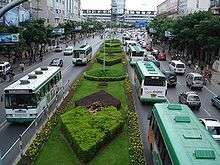
Road and transit
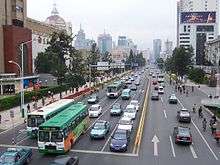
Yunnan has built a comprehensive highway system with roads reaching almost all the major cities or towns in the region. Bus travel across the region is extensive. Buses head from Kunming to destinations such as Dali and Lijiang several times a day.
There are four major long-distance bus stations in Kunming with the South Bus Station and Railway Square Bus Station being the most primary.
- South Bus Station faces the Kunming Railway Station in Beijing Xi Lu, with standard, luxury, express and sleeper buses departing for all over Yunnan and neighboring provinces.
- Railway Square Bus Station is smaller than SBS and the majority of the buses depart from the station are private-run. Usually no fixed schedules are available and buses will leave when they are full. There are standard and sleeper services to Dali, Jinghong and elsewhere in Yunnan.
Leaving China by road into Vietnam and Laos is also possible through the respective crossings at Hekou in southeastern Yunnan or Bian Mao Zhan in Xishuangbanna.
The Kunming–Bangkok Expressway is the first expressway from China to Bangkok via Laos. The 1,800 km (1,100 mi) long Kunming–Bangkok Expressway begins at Kunming going down to Ban Houayxay in Laos; it then crosses the Mekong River to Chiangkhong in Thailand and eventually reaches Bangkok.
At the 14th Greater Mekong Subregion Ministerial Conference in July 2007, China, Laos and Thailand signed an agreement on the construction of a new bridge over the Mekong River to connect Chiangkhong in Thailand and Ban Houayxay in Laos, to the Kunming–Bangkok Highway. The completion of the new bridge over the Mekong River will help connect China's southeast provinces with Bangkok. With capital investments from both China and Thailand, the bridge is expected to be completed in 2011 and will be the last link in the highway system that winds through the Mekong River region.
Local transit
Public buses and taxis are the two main means of transport within the city. A metro system is currently under construction (see Kunming Metro).
Nearly two hundred public bus lines crisscross the city center, covering the whole prefecture.
Cycling is common, and many hotels around the Kunming Railway Station provide bicycle rental services.
Conscious of its growing traffic issues, the city is currently renovating a pedestrian-friendly city centre.
Central Kunming
The city hangs off two main thoroughfares: Beijing Lu forms the north-south axis, passing just east of the center as it runs for 5 km (3.1 mi) between the city's two trains stations; while Dongfeng Lu crosses it halfway along, divided into east (Dongfeng Dong Lu), middle (Dongfeng Zhong Lu) and west (Dongfeng Xi Lu) sections as it cuts right through the business center. The far end runs out of the city as Renmin Xi Lu, the first leg of the Burma Road. Most of the city's famous hotels and foreign consulates lies along Dongfeng Dong Lu and the southern half of Beijing Lu, while the majority of specific landmarks and shopping district are north and west of the center around Dongfeng Xi Lu and Cuihu Park (Green Lake Park). Circling most of this is the city's first highway ring road, Huancheng Lu, though others are planned.
Education and research
Kunming remains a major educational and cultural center in the southwest region of China, with universities, medical and teacher-training colleges, technical schools, and scientific research institutes.
Colleges and universities
- Kunming Medical University
- Kunming Metallurgy College
- Kunming University
- Kunming University of Science and Technology (1925)
- Southwest Forestry University
- Yunnan Agricultural University
- Yunnan Arts University
- Yunnan Normal University
- Yunnan Normal University Business School
- Yunnan University (1922)
- Yunnan University of Finance and Economics
- Yunnan Nationalities University
- Yunnan University of Traditional Chinese Medicine
Yunnan University
Yunnan university (云南大学), located in Kunming, is one of the largest and the most prestigious universities in China and is the only university in Yunnan province which has been developed into a “National Key University”. It was founded in 1922, as "University of the Eastern Land”. Its name has been changed six times subsequently. The institution has 17 schools on the local campus and 3 independent schools located in other cities. It claims the largest and best law school in Yunnan province.[34]
Yunnan Normal University
Yunnan Normal University (云南师范大学) was founded in 1938 as the National Normal College of Southwestern Union University. In 1946, when some faculties returned to the north of China, it changed its name to National Kunming Normal College. It now as 6 campuses in Kunming itself and other cities. With 22 schools, it has an enrollment of some 33000 undergraduate students.[35]
Kunming University of Science and Technology
Kunming University of Science and Technology (昆明理工大学) was established in 1954 and was given "key university" status in 2010. In 2017, it had 3 campuses in Kunming housing 24 schools and had an enrollment of27000 undergraduates.[36]
Yunnan Nationalities University
Yunnan Nationalities University was founded in 1951 as Yunnan Nationalities College. It is now one of six "key" universities in the province. It has established cooperative relations with 26 foreign universities including University of Bergen in Norway, La Trobe University in Australia, and University of Virginia in the United States. The university has a Nationalities Museum, which contains more than 20000 rare exhibits. There are more than 23000 undergraduates on campus.[37]
Huayang Academy
Huayang Academy is a specialist Chinese language training centre considered unique for offering training Kunming dialect as well as standard Mandarin. Its locality is a popular centre of Western culture in Kunming, attracting numerous foreign-owned businesses.[38]
Management training
The Shanghai-based China Europe International Business School, aka CEIBS, will launch in 2009 its Business Development Certificate Programme in Kunming. With the Business Development Certificate Programme, CEIBS and program partner Frankfurt School of Finance & Management aim to train approximately 500 Chinese managers in the coming four years, with the first phase of the program beginning in 2008 in Hefei, the capital of Anhui province. Kunming and Harbin will be the focus of the program's expansion in 2009. The program is part of a two million Euro umbrella project funded by the EU, which also includes another program that provides scholarships for MBA students from China's less-developed regions.[39]
Research institutes
- Solar Energy Research Institute of Yunnan Normal University
- Kunming Municipal Planning and Design Research Institute
Chinese Academy of Sciences
The Kunming Branch of the Chinese Academy of Sciences (CAS) was established in 1957. It was formerly known as Kunming Office of CAS and was extended into a branch in 1958 and renamed as Yunnan Branch of CAS. In 1962, Yunnan Branch combined with Sichuan Branch and Guizhou Branch to establish Southwest China Branch of CAS in Chengdu. In October 1978, Kunming Branch was reestablished at the approval of the State Council.
As a working department of CAS, Kunming Branch now administers five research institutes:
- Kunming Institute of Botany, Chinese Academy of Sciences
- Kunming Institute of Medical Biology, Chinese Academy of Sciences
- Kunming Institute of Zoology, Chinese Academy of Sciences
- Kunming Primate Research Center, Chinese Academy of Sciences
- Xishuangbanna Tropical Botanical Gardens in Menglun, Mengla County, Xishuangbanna Dai Autonomous Prefecture, far southern Yunnan.
At present, it has a total staff of 1,160, of which 808 are professional researchers, 7 academicians and 343 senior researchers. There are also 447 Ph.D. degree students and 530 master's degree students. The retired staff is 1,090. The Branch has set up 3 national key open labs, 2 CAS key open labs, 5 key labs set up by CAS and local province, 3 engineering centers, 5 doctoral sites, 5 post doctoral stations and national famous plant herbariums and halls of wildlife specimens and has a series of up-to-date research instruments and apparatus, computer networks and biodiversity information systems. The Branch has become an advanced comprehensive science research base in astronomy, geology and biology.
Libraries
Twin towns and sister cities
Kunming currently maintains sister city agreements with the following foreign cities.[40]
| City | Region | Country | Date |
|---|---|---|---|
| Kanagawa | Japan | 1981-01-15 | |
| Zürich | Switzerland | 1982-02-17 | |
| Tanger-Tetouan-Al Hoceima | Morocco | 1985-05-14 | |
| Colorado | United States | 1986-05-15 | |
| New South Wales | Australia | 1988-08-14 | |
| Cochabamba | Bolivia | 1997-09-25 | |
| Chiang Mai | Thailand | 1999-06-07 | |
| Mandalay | Myanmar | 2001-05-10 | |
| Taranaki | New Zealand | 2003-08-11 | |
| Chittagong | Bangladesh | 2005-08-18 | |
| Central Finland | Finland | 2008-09-18 | |
| Yangon | Myanmar | 2008-12-01 | |
| - | Cambodia | 2011-06-08 | |
| North Central Province | Sri Lanka | 2011-07-27 | |
| Vientiane | Laos | 2011-10-17 | |
| Antalya | Turkey | 2013-05-10 | |
| Gandaki Pradesh | Nepal | 2013-07-08 | |
| West Bengal | India | 2013-10-23 | |
| New York | United States | 2014-03-25 | |
| - | Vietnam | 2015-02-06 | |
| Alpes-Maritimes | France | 2016-03-27 | |
| Olomouc | Czech Republic | 2017-09-11 |
Health
Currently, there are 2,774 medical institutes of various kinds and 33,600 medical professionals in the City. The 170 medical service institutes based on communities cover a population of 1.86 million.[41] China Health Management Corp (CNHC) is the main private healthcare provider in the city. It has been predicted that private hospitals will provide 70 percent of total medical health care services by 2012 within Kunming City.[42]
Hospitals in Kunming include:
- Yunnan Provincial Red Cross Hospital and Emergency Center, is the main general hospital in Kunming.
- Yunnan Provincial First People's Hospital
- First Affiliated Hospital of Kunming Medical College
- Kunming Mental Hospital, founded in 1955, houses over 400 patients.
- Kunming Physical Rehabilitation Center
HIV/AIDS
In late 2006, China's first provincial-level HIV/AIDS treatment center was built. The US$17.5 million center is located 28 km (17 mi) from downtown Kunming. The center has six main departments: clinical treatment, technical consulting, research and development, international exchange and cooperation, clinical treatment training and psychological therapy.
Yunnan, with a population of more than 45 million, leads China in HIV/AIDS infections: primarily spread through intravenous drug use and unsafe sex, often involving the sex industry. According to official statistics, by the end of 2005, Yunnan was home to more than 48,000 HIV-infected patients, 3,900 patients with AIDS and a death toll of 1,768.[43]
Military
Kunming is headquarters of the 14th Group Army of the People's Liberation Army, one of the two group armies that comprise the Chengdu Military Region responsible for the defense of China's southwestern borders with India and Myanmar, as well as security in Tibet.
Public security and crime
The headquarters of the Kunming Municipal Public Security Bureau is on Beijing Lu. Its foreign affairs department, located on Jinxing Huayuan, Jinxing Xiao Lu in the northeast of the city, handles immigration and travel visas.[44]
Drug trafficking
Kunming has a pivotal role as a major conduit point in international drug trafficking as it is the closest major Chinese city situated near the Golden Triangle in Southeast Asia. The Kunming Municipal Public Security Bureau Narcotics Squad is the specialist counter-narcotics police service.
Police confiscated at least three tons of drugs in Yunnan in 2005. Yunnan province seized 10 tons of illegal drugs in 2006, accounting for 80 percent of the total drugs confiscated nationwide during the period, according to Sun Dahong, then deputy director of Yunnan's provincial Public Security Bureau. The total is more than double the amount seized in the province in 2005.[45]
Heroin and methamphetamine seem to be the main targets of the 30,000+ strong anti-drug police in Yunnan. The majority of heroin coming into China from the Golden Triangle passes through Dali from where it is then distributed to the rest of China and internationally via China's coastal cities.
Kunming Municipal Compulsory Rehabilitation Center in Kunming is the main rehabilitation center for drug addicts, mostly recovering from heroin addiction. International drug rings have used Yunnan and Kunming to channel new synthetic drugs (like methamphetamine) as well as traditional drugs like heroin.
Opium was until recently in widespread medicinal use by many of the minority peoples of the province; however, after the Opium War the Chinese government has made growing the poppy illegal, and all but stamped out its production within the borders of Yunnan.
International relations
The following countries have a diplomatic mission in Kunming:
Trade offices:
Notable residents
Notable people from Kunming include:
- Benedict Anderson, scholar (born in Kunming)
- Cai Xitao, botanist
- Chih-Kung Jen, physicist
- Pierre Jean Marie Delavay, 19th-century French missionary, lived and died in Kunming
- Lamu Gatusa, professor and writer
- Li Weiwei, Olympics handball player
- Liu Fang, pipa player
- Maran Brang Seng, Burmese politician (died in Kunming)
- Nie Er, composer (born in Kunming)
- Frank Shu, Chinese-American astrophysicist, born in Kunming
- Tang Jiyao, general and warlord of Yunnan, died in Kunming
- Tu Wei-ming, ethicist (born in Kunming)
- Wang Hongni, triathlete and Asian Games gold medallist
- Wen Yiduo, poet and scholar, (lived and assassinated in Kunming)
- Anthony Zee, physicist
- Zhang Xiaogang, artist, born in Kunming
- Zhu De, military leader (studied in Kunming)
- Zhu Youlang (Ming dynasty emperor), (fought and was executed in Kunming)
Diplomats:
- Auguste François, French consul in south China
- George Soulié de Morant, French diplomat
- John S. Service, American diplomat served in Kunming for two years
National Southwestern Associated University:
- Chen Ning Yang, physicist
- Chen Yinke, linguist
- Feng Youlan, philosopher
- Shiing-Shen Chern, mathematician
- Ta-You Wu, physicist
- Tsung-Dao Lee, physicist
- Wang Yuan, mathematician
- Wu Ningkun, professor emeritus
- Zhang Boling, founder of Nankai University
See also
- Zheng He
- List of twin towns and sister cities in China
- Kunming Wolfdog, an established breed of wolf-dog hybrid.
- List of cities in the People's Republic of China
- 2008 Kunming bus bombings
- 3650 Kunming
- Category:Films set in Kunming
References
- ↑ "Online 1911 Encyclopædia Britannica". Archived from the original on 26 May 2007. Retrieved 30 June 2016.
- ↑ Cox, W (2018). Demographia World Urban Areas. 14th Annual Edition (PDF). St. Louis: Demographia. p. 24.
- ↑ Cox, W (2018). Demographia World Urban Areas. 14th Annual Edition (PDF). St. Louis: Demographia. p. 24.
- 1 2 "Global Metro Monitor 2014". Brookings Institution. Retrieved 25 February 2016.
- ↑ "Illuminating China's Provinces, Municipalities and Autonomous Regions". PRC Central Government Official Website. Retrieved 17 May 2014.
- ↑ "15-2各州市户数、人口数及构成(2014年)-tjsql.com". www.tjsql.com. Retrieved 6 March 2016.
- ↑ The Peopling of East Asia, pp. 192
- ↑ "Social Needs and Aspirations: Heritage, Urbanization, Revitalization, Lifestile, and Accessibility". Creativity and Culture in Greater China: The Role of Government, Individuals, & Groups.
- 1 2 "Lieutenant General Claire Lee Chennault Memorial – Find A Grave Memorial". Retrieved 30 June 2016.
- ↑ "Last Stand". Time magazine. 19 December 1949. Retrieved 3 December 2007.
- ↑ "Special Operations Association" (2005) By Special Operations Association. Turner Publishing. ISBN 1-59652-156-2
- ↑ Rossi, J.R. "History: The Flying Tigers — American Volunteer Group — Chinese Air Force".
- ↑ "AIM25 collection description". Aim25.ac.uk. Retrieved 23 December 2011.
- ↑ "China hosts giant horticultural expo". BBC World Service. 1 May 1999. Retrieved 21 January 2008.
- ↑ "(Xinhua)". English.people.com.cn. 31 July 2006. Retrieved 23 December 2011.
- ↑ "Chinese security official vows harsh punishment for terrorists". Xinhua News Agency. 2 March 2014. Archived from the original on 5 March 2014. Retrieved 2 March 2014.
- ↑ "Climate of Kunming". Chinakunming.travel. Archived from the original on 27 January 2012. Retrieved 23 December 2011.
- ↑ "ref". km.gov.cn.
- ↑ Kunming Plans to Establish Environment Court Archived 4 October 2008 at the Wayback Machine. (CRIENGLISH.com 22 September 2008)
- ↑ "新昆明网". Newkm.cn. Archived from the original on 1 October 2011. Retrieved 23 December 2011.
- ↑ Ma, Guihua (29 June 2004). "A farewell to two zoos?". China Daily. Retrieved 21 January 2008.
- ↑ LaFraniere, Sharon (26 March 2010). "A Miniature World Magnifies Dwarf Life". The New York Times. Retrieved 13 May 2011.
- 1 2 3 "China's high-altitude training centers". Gokunming.com. Retrieved 23 December 2011.
- 1 2 Spring City Blooming Archived 4 January 2008 at the Wayback Machine.
- ↑ "Archived copy". Archived from the original on 6 October 2008. Retrieved 17 November 2008.
- ↑ Bradsher, Keith (25 September 2006). "Bouquet of Roses May Have Note: 'Made in China'". The New York Times.
- ↑ "Kunming aims to build a city run by solar energy". emerging-china.com.
- ↑ 滇越铁路徒步第一程(昆明——宜良) (A walk along the Kunming-Vietnam Railway. Part 1: Kunming-Chenggong)
- ↑ Qiao Changhong (乔长红), 昆明南窑火车站年底有望通高铁. 昆明铁路枢纽扩能改造工程年底完工,滇池环线铁路将闭合 Archived 28 February 2017 at the Wayback Machine. (Kunming's Nanyao Station is expected to get high-speed service by the end of the year. Kunming Railway Hub Expansion and Reorganization Project to be completed by the end of the year, the railway ring around Dian Lake to be completed). 2017-02-28
- ↑ "Kunming opens more metro lines". Railwaygazette. Retrieved 25 July 2014.
- ↑ "Metro Line 3 construction to start this month". GoKunming: Kunming & Yunnan living, business, travel. Retrieved 22 July 2012.
- ↑ "China continues building the Pan Asian High speed railway network". Next Big Future. 28 April 2016. Retrieved 29 April 2016.
- ↑ Myanmar in China’s Push into the Indian Ocean, Joshy M Paul, March 14, 2016, retrieved 20 January 2017
- ↑ {rl=云南大学}
- ↑ { url=云南师范大学 }
- ↑ { url=昆明理工大学 }
- ↑ { url=云南民族大学 }
- ↑ "Chinese language school Kunming - Huayang Academy". learnchineseinyunnan.com. Retrieved 2016-04-29.
- ↑ "CEIBS Launches Business Development Certificate Programme in Hefei". Ceibs.edu. 5 September 2008. Retrieved 22 July 2012.
- ↑ 全国各省、自治区、直辖市建立友好城市统计-云南 [Friendly city statics - Yunnan]. www.cifca.org.cn (in Chinese). 中国国际友好城市联合会. Retrieved 2018-08-30.
- ↑ "Economic Situation-Kunming Tour". Chinakunming.travel. Archived from the original on 14 July 2012. Retrieved 22 July 2012.
- ↑ China Health Management Corp.: Members of the Standing Committee of Yunnan Province and Government Officials Pay Visit to Richland International Hospital 16 June 2008
- ↑ Bacaër, Nicolas; Xamxinur Abdurahman; Jianli Ye (April 2006). "Modeling the HIV/AIDS Epidemic Among Injecting Drug Users and Sex Workers in Kunming, China". Bulletin of Mathematical Biology. Springerlink.com. 68 (3): 525–550. doi:10.1007/s11538-005-9051-y. Retrieved 22 July 2012.
- ↑ "昆明市公安局西山分局涉外网络警务室". 8599999.net. Archived from the original on 24 June 2012. Retrieved 22 July 2012.
- ↑ "Yunnan Witnesses Record Drug-busting 2006". china.org.cn. 31 December 2006. Retrieved 22 July 2012.
- ↑ "Redirecting". Retrieved 30 June 2016.
Further reading
- Kunming Statistical Yearbook-2007 (in Chinese) China Statistics Press .
- Qi Duxia (1999). A Complete Guide Series of Travel and Tourism in China — Kunming. China Travel & Tourism Press. ISBN 7-5032-1491-0.
- Carl Fingerhuth, Ernst Joos (2002). The Kunming Project: Urban Development in China — A Dialogue. Birkhauser Verlag AG. ISBN 3-7643-6742-3.
- Sustainable Urban Development – the Case Study of Kunming, China Willy Schmid, Markus Eggenberger, 1997.
- NSL – Network City and Landscape – contains Kunming sustainable development papers
- Franklin, B. Evans (2005). 600 Days in Kunming China, 1944–45. AuthorHouse. ISBN 1-4208-2117-2.
- Maochun Yu (1997). OSS in China: Prelude to Cold War. Yale University Press. ISBN 0-300-06698-8.
- Cai, Le; Chongsuvivatwong, Virasakdi (2006). "Rural-urban differentials of premature mortality burden in south-west China". International Journal for Equity in Health. 5: 13. doi:10.1186/1475-9276-5-13.
- Remick, Elizabeth J. (2007). "Police-Run Brothels in Republican Kunming". Modern China. 33 (4): 423–461. doi:10.1177/0097700407304804. Archived from the original on 2008-12-08.
- Chin, K. and Zhang, S. "Street-Level Heroin Sales in Kunming, China". American Society of Criminology (ASC) 2008-06-26
- Kunming Communiqué on Cross-border Collaboration for Drug Demand Reduction and HIV/AIDS Prevention Social Development Division, United Nations ESCAP
- Kobusingye KA. Voluntary counseling and testing among injecting drug users in Kunming city, Yunnan Province Int Conf AIDS. 2004 Jul 11–16; 15: abstract no. WePeC5999.
- China's Disabled Get Helping Hand in High Places Kunming Journal. Nicholas D. Kristof. 30 May 1991
- Book about Kunming's regional cooperation with Southeast Asia: ASEAN-China Relations: Realities and Prospects (2005) Saw Swee Hock, Lijun Sheng, Sheng Lijun, Kin Wah Chin, Chin Kin Wah. Institute of Southeast Asian Studies (ISEAS) ISBN 981-230-342-1
- Wei Xing. "Prevalence of ethnic intermarriage in Kunming: Social exchange or insignificance of ethnicity?" Asian Ethnicity, Volume 8, Issue 2 June 2007, pages 165–179
- Jianli Li; Mary Francis Marx. "A Survey of Four Libraries in Kunming: Library Automation and Modernization in a Far Removed Province in China" Journal of Southern Academic and Special Librarianship (2000)
External links
| Wikimedia Commons has media related to Kunming. |
- Official Kunming Municipal Government Website
- Official Kunming Website (Chinese & English)

Largest cities or municipalities in China Sixth National Population Census of the People's Republic of China (2010) | |||||||||
|---|---|---|---|---|---|---|---|---|---|
| Rank | Name | Province | Pop. | Rank | Name | Province | Pop. | ||
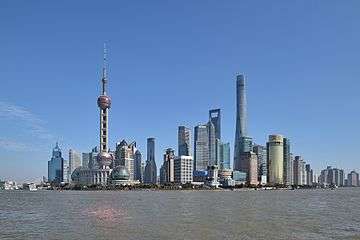 Shanghai 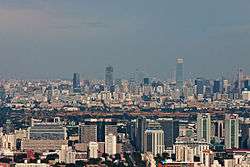 Beijing |
1 | Shanghai | Shanghai | 20,217,700 | 11 | Foshan | Guangdong | 6,771,900 |  Chongqing 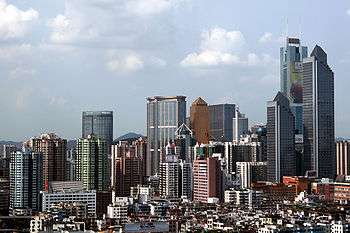 Guangzhou |
| 2 | Beijing | Beijing | 16,858,700 | 12 | Nanjing | Jiangsu | 6,238,200 | ||
| 3 | Chongqing | Chongqing | 12,389,500 | 13 | Shenyang | Liaoning | 5,890,700 | ||
| 4 | Guangzhou | Guangdong | 10,641,400 | 14 | Hangzhou | Zhejiang | 5,849,500 | ||
| 5 | Shenzhen | Guangdong | 10,358,400 | 15 | Xi'an | Shaanxi | 5,399,300 | ||
| 6 | Tianjin | Tianjin | 10,007,700 | 16 | Harbin | Heilongjiang | 5,178,000 | ||
| 7 | Wuhan | Hubei | 7,541,500 | 17 | Dalian | Liaoning | 4,222,400 | ||
| 8 | Dongguan | Guangdong | 7,271,300 | 18 | Suzhou | Jiangsu | 4,083,900 | ||
| 9 | Chengdu | Sichuan | 7,112,000 | 19 | Qingdao | Shandong | 3,990,900 | ||
| 10 | Hong Kong | Hong Kong | 7,055,071 | 20 | Zhengzhou | Henan | 3,677,000 | ||
